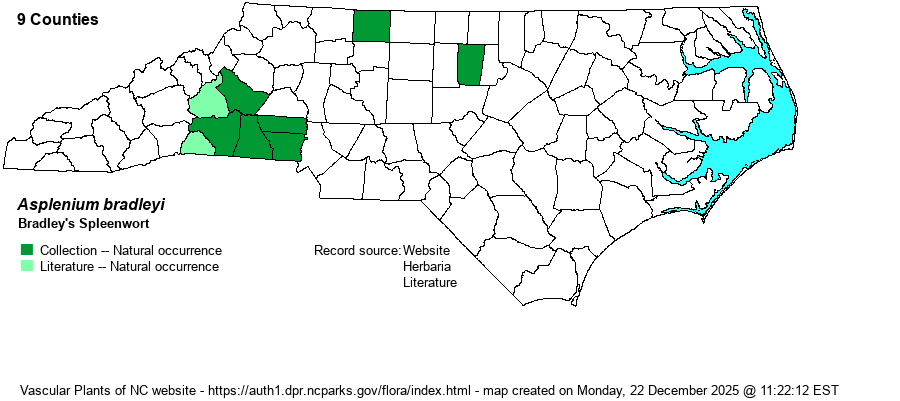| Author | D.C. Eaton | |
| Distribution | Mainly in the southwestern Piedmont, on monadnocks and outlier montane ranges; barely extending to the Blue Ridge Escarpment. Isolated records in the northern and northeastern Piedmont, in Stokes and Orange counties, where still extant.
This is an Eastern species, ranging from southern NY and MO south to central GA and eastern OK, being most widespread west of the Appalachians, in lower elevation mountain ranges.
| |
| Abundance | Rare, to locally uncommon in Hickorynut Gorge and the South Mountains regions, in the western part of the state range. The NCNHP database contains 13 records, of which 10 are still extant. This is a Significantly Rare species. | |
| Habitat | This is a rock-requisite species, growing in crevices, mostly on vertical or near-vertical faces, of dry felsic rocks. It grows on sandstone, quartzite, and several other such sedimentary or metasedimentary rocks. |
| Phenology | Fruits from April until October. | |
| Identification | This is a rather typical member of the genus, with a number of fronds growing in a clump. The shining brown stipe averages about 3-4 inches long, with the rather narrowly oblong blade about 6-8 inches long and 1.5 inches wide, one-pinnate-pinnatifid. The pinnae are short and triangular, barely 3/4-inch long, mostly alternate to barely sub-opposite, and only partly cut to the midrib into about 7-9 lobes. The sori are short, numerous, most oriented diagonally to the midrib under each pinna. The species is best told from other Aspenium species by the stipe being shiny brown to black from the base to the lowest pinnae; similar ones like A. montanum and A. pinnatifidum have the stipe entirely green or only partly darkened at the base. | |
| Taxonomic Comments | None
| |
| Other Common Name(s) | Cliff Spleenwort | |
| State Rank | S2 | |
| Global Rank | G4 | |
| State Status | SR-P | |
| US Status | | |
| USACE-agcp | | |
| USACE-emp | | |

